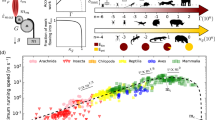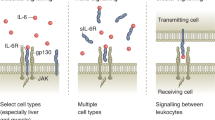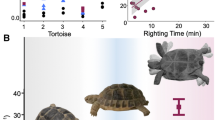Abstract
Why are sustained energy budgets of humans and other vertebrates limited to not more than about seven times resting metabolic rate? The answer to this question has potential applications to growth rates, foraging ecology, biogeography, plant metabolism, burn patients and sports medicine.
This is a preview of subscription content, access via your institution
Access options
Subscribe to this journal
Receive 51 print issues and online access
$199.00 per year
only $3.90 per issue
Buy this article
- Purchase on Springer Link
- Instant access to full article PDF
Prices may be subject to local taxes which are calculated during checkout
Similar content being viewed by others
References
Westerterp, K. R. et al. Use of the doubly labeled water technique in humans during heavy sustained exercise. J. Appl. Physiol. 61, 2162–2167 (1986).
Petersen, C. C. et al. Sustained metabolic scope. Proc. Natl Acad. Sci. USA 87, 2324–2328 (1990).
Drent, R. H. & Daan, S. The prudent parent: energetic adjustments in avian breeding. Ardea 68, 225–252 (1980).
Weiner, J. Metabolic constraints to mammalian energy budgets. Acta Theriol. 34, 3–35 (1989).
Taylor, C. R. & Weibel, E. R. Design of the mammalian respiratory system. I. Problems and strategy. Resp. Physiol 44, 1–10 (1981).
Toloza, E. et al. Nutrient extraction by cold-exposed mice: a test of digestive safety margin. Am. J. Physiol. 261, G608–620 (1991).
Konarzewski, M. & Diamond, J. M. Peak sustained metabolic rate and its individual variation in cold-stressed mice. Physil. Zool. 67, 1186–1212 (1994).
Hammond, K. A. et al. Metabolic ceilings under a combination of peak energy demands. Physiol. Zool. 68, 1479–1506 (1994).
Hammond, K. A. & Diamond, J. M. Limits to dietary nutrient intakes and intestinal nutrient uptakes in lactating mice. Physiol. Zool. 67, 282–303 (1994).
Daan, S. et al. Avian basal metabolic rates: their association with body composition and energy expenditure in nature. Am. J. Physiol. 259, R333–340 (1990).
Koteja, P. On the relation between basal and field metabolic rates in birds and mammals. Funct. Ecol. 5, 56–64 (1991).
Ricklefs, R. E. et al. The relationship between basal metabolic rate and daily energy expenditure in birds and mammals. Am. Nat. 147, 1047–1071 (1996).
Else, P. L. & Hulbert, A. J. Comparison of the ‘mammal machine’ and the ‘reptile machine’: energy production. Am. J. Physiol. 240, R3–9 (1981).
Peters, R. H. The Ecological Implications of Body Size (Cambridge Univ. Press, Cambridge, 1983).
Nagy, K. A. Field metabolic rate and food requirement scaling in mammals and birds. Ecol. Monogr. 57, 111–128 (1987).
Hammond, K. A. & Diamond, J. M. An experimental test for a ceiling on sustained metabolic rate in lactating mice. Physiol. Zool. 65, 952–977 (1992).
Secor, S. M. et al. Rapid upregulation of snake intestine in response to feeding—a new model of intestinal adaptation. Am. J. Physiol. 266, G695–705 (1994).
Secor, S. M. & Diamond, J. M. Adaptive responses to feeding in Burmese pythons—pay before pumping. J. Exp. Biol. 198, 1313–1325 (1995).
Karasov, W. H. et al. What transport adaptations enable mammals to absorb sugars and amino acids faster than reptiles? Am. J. Physiol. 249, G271–283 (1985).
Rensch, I. & Rensch, B. Relative Organmasse bei tropischen Warmblütern. Zool. Anzeiger 156, 106–124 (1956).
Konarzewski, M. & Diamond, J. M. Evolution of basal metabolic rate and organ masses in laboratory mice. Evolution 49, 1239–1248 (1995).
Martin, A. W. & Fuhrman, F. A. The relationship between summated tissue respiration and metabolic rate in the mouse and dog. Physiol. Zool. 28, 18–34 (1955).
Johnson, D. E. et al. Changes in liver and gastroinetestinal tract energy demands in response to physiological workload in ruminants. J. Nutr. 120, 649–655 (1990).
Weibel, E. R. et al. Diversity in Biological Design (Cambridge Univ. Press, Cambridge, 1997).
Root, T. Energy constraints on avian distribution and abundances. Ecology 69, 330–339 (1988).
Ricklefs, R. E. Adaptation, constraint, and compromise on avian post-natal development. Biol. Rev. 54, 269–290 (1979).
Amthor, J. S. Respiration and Crop Productivity (Springer, New York, 1989).
Hansen, L. D. et al. Prediction of long-term growth rates of larch clones by calorimetric measurement of metabolic heat rates. Can. J. For. Res. 19, 606–611 (1989).
Royall, D. et al. Continuous measurements of energy expenditure in ventilated burn patients: an analysis. Critical Care Med. 22, 399–406 (1994).
Koteja, P. et al. Maximum cold and lactation induced rate of energy assimilation in Acomys cahirinus. Polish Ecol. Studies 20, 369–374 (1994).
Koteja, P. Maximum cold-induced energy assimilation in a rodent, Apodemus flavicollis. Comp. Biochem. Physiol. 112, 479–485 (1995).
McDevitt, R. M. & Speakman, J. R. Central limits to sustainable metabolic rate have no role in cold acclimation of the short-tailed field vole (Microtus agrestis). Physiol. Zool. 67, 1117–1139 (1994).
Hayes, J. P. Altitudinal and seasonal effects on aerobic metabolism of deer mice. J. Comp. Physiol. 159, 453–459 (1989).
Kenagy, G. J. et al. Energy expenditure during lactation in relation to litter size in free-living golden-mantled ground squirrels. J. Anim. Acol. 59, 73–88 (1990).
Poppitt, S. D. et al. Energetics of reproduction in the lesser hedgehog tenrec Echinops telfairi (Martin). Physiol. Zool. 67, 976–994 (1994).
Roby, D. D. & Ricklefs, R. E. Energy expenditure in adult least auklets and diving petrels during the chick-rearing period. Physiol. Zool. 59, 661–678 (1986).
Bryant, D. C. et al. Reproductive energetics of two tropical bird species. Auk 101, 25–37 (1984).
Obst, B. S. et al. Energy utiization by Wilson's storm-petrels (Oceanites oceanicus). Physiol. Zool. 60, 200–210 (1987).
Brit-Friesen, V. L. et al. Activity-specific metabiic rates of free-living northern gannets and other seabirds. Ecology 70, 357–367 (1989).
Adams, N. J. et al. Energy expenditure and food consumption by breeding Cape gannets Morus capensis. Mar. Ecol. Progr. Ser. 70, 1–9 (1991).
Ballance, L. T. Flight energetics of free-ranging red-footed boobies (Sula sula). Physiol. Zool. 68, 887–914 (1995).
Koteja, P. Limits to the energy budget in a rodent, Peromyscus maniculatus: the central limitation hypothesis. Physiol. Zool. 69, 981–993 (1996).
Koteja, P. Limits to the energy budget in a rodent, Peromyscus maniculatus: does gut capacity set the limit? Physiol. Zool. 69, 994–1020 (1996).
Panter-Brick, C. Seasonality of energy expenditure during pregnancy and lactation for rural Nepali women. Am. J. Clin. Nutr. 57, 620–628 (1993).
Author information
Authors and Affiliations
Rights and permissions
About this article
Cite this article
Hammond, K., Diamond, J. Maximal sustained energy budgets in humans and animals. Nature 386, 457–462 (1997). https://doi.org/10.1038/386457a0
Issue Date:
DOI: https://doi.org/10.1038/386457a0
This article is cited by
-
Energetic and behavioral consequences of migration: an empirical evaluation in the context of the full annual cycle
Scientific Reports (2023)
-
Fur removal promotes an earlier expression of involution-related genes in mammary gland of lactating mice
Journal of Comparative Physiology B (2023)
-
Metabolic trait diversity shapes marine biogeography
Nature (2020)
-
Use of social thermoregulation fluctuates with mast seeding and reproduction in a pulsed resource consumer
Oecologia (2020)
-
Mitochondrial physiology varies with parity and body mass in the laboratory mouse (Mus musculus)
Journal of Comparative Physiology B (2020)
Comments
By submitting a comment you agree to abide by our Terms and Community Guidelines. If you find something abusive or that does not comply with our terms or guidelines please flag it as inappropriate.



